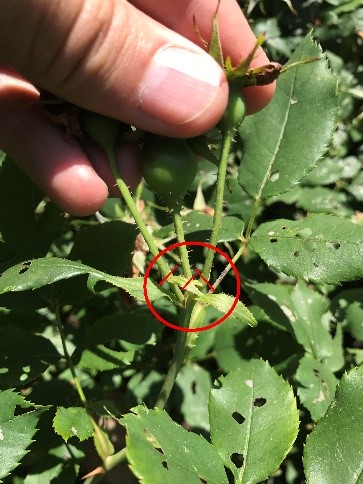This article will discuss how to extend the blooming season of knock-out rose (rosa sp.) bushes through “deadheading”.
Landscaping Rose Bushes in St. LouisBefore we get started…a few comments on safety and hygiene.


The practice of deadheading is not required of roses; it is a proactive practice for those wishing to extend the blooming season by promoting additional growth cycles. A rose bush will “self-clean” which means it will undergo an abscission process by which spent blooms and dead stems are terminated and eventually fall off (see photo, right).
For those wishing to add growth cycles, which results in additional blooms, then deadheading is for you. By late May or June (at least in the St. Louis area) most knock-out roses have completed a growth cycle – new burgundy stems and flowers appear in early spring and are followed by multiple large rose blooms. Those blooms eventually die and fall to the ground leaving behind the spent bloom (see photo, left).


The object of deadheading is to remove the bloom down to the nearest bud without damaging the bud. This process can be completing by finding the nearest bud and clipping the stem at a 45 degree angle (see photo, right). As you get more efficient in clipping blooms, this can be accomplished by holding the bloom with one hand and clipping the stem with a pair of scissors in the other hand. Work your way around the entire bush, cleaning out all the spent blooms. While cleaning out the blooms, also look for dead stems – these will appear dark brown or gray in color. The stem will typically die back to a union and this will be most obvious by a change in color, usually back to green. The stem can be clipped at this union, but be sure not to damage the live tissue on nearby stems.
New growth will soon appear (see photo, left) and will be followed by additional flowering. One comment we will make on deadheading related to timing – the process of removing spent blooms will trigger a cellular response from the plant causing a new growth cycle to begin. If all blooms are cut at one time, the new flowers will likely appear around the same time. If you would like to stagger the new growth, then consider pruning 30-50% at a time, then doing the rest a week or two later. Since soil, sunlight, temperature and water conditions vary with all locations, try different techniques to determine what best fits your landscape. Rose bushes are very forgiving when it comes to pruning, so minor deadheading mistakes are rarely fatal to plant. In anticipation for winter, stop deadheading to allow the plant time to prepare for the cold…
Have questions? Give us a call at (314) 814-0809 or visit www.clippertreeservice.com













